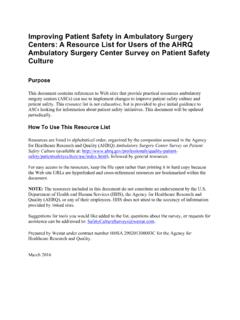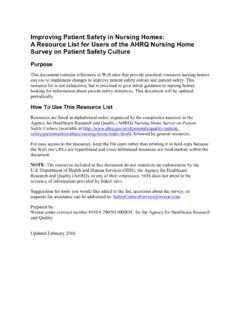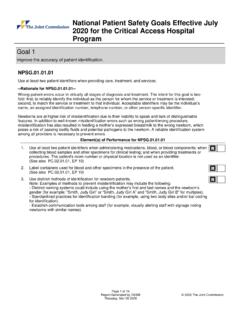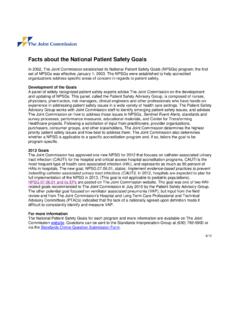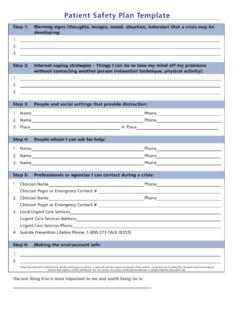Transcription of The NHS Patient Safety Strategy - NHS England
1 The NHS Patient Safety Strategy Safer culture, safer systems, safer patients July 2019. NHS England and NHS Improvement The NHS Long Term Plan says that when organisations work together they provide better care for the public. That is why on 1 April 2019 NHS Improvement and NHS England united as one our aim, to provide leadership and support to the wider NHS. Nationally, regionally and locally, we champion frontline staff who provide a world-class service and constantly work to improve the care given to the people of England . Contents Foreword .. 3. Summary .. 4. Insight .. 4. Involvement .. 5. Improvement .. 5. 6. Our vision for Patient Safety .. 6. Foundations for safer care: where we are now and where we need to go .. 7. A Patient Safety culture .. 7. A Patient Safety system .. 11. Safety in primary care .. 14. What the NHS is going to do .. 18. Insight .. 19. Measurement.
2 19. A new digital system to support Patient Safety learning .. 20. The Patient Safety Incident Response Framework .. 22. The Healthcare Safety Investigation Branch (HSIB).. 25. The medical examiner system .. 26. National clinical review and response .. 28. The National Patient Safety Alerts Committee .. 29. Clinical negligence and litigation .. 30. Involvement .. 34. patients , carers, families and lay people as partners .. 34. Patient Safety education and training .. 37. Patient Safety specialists .. 40. Safety I and Safety II .. 42. Independent sector .. 43. Improvement .. 45. Continuous improvement .. 45. The National Patient Safety Improvement Programme .. 45. The Maternity and Neonatal Safety Improvement 48. 1 | Contents The Medicines Safety Improvement Programme .. 50. The Mental Health Safety Improvement Programme .. 53. Safety issues that particularly affect older people.
3 54. Safety and learning disabilities .. 55. Antimicrobial resistance and healthcare associated infections .. 58. Research and innovation .. 60. Delivering the Strategy .. 62. List of contributors .. 73. Appendix 1: Benefits 76. Estimating current impact of harm in the 76. Estimating the benefits of the Strategy .. 78. 2 | Contents Foreword We are not here to curse the darkness, but to light the candle that can guide us through that darkness to a safe and sane future. (John F Kennedy, 1960). JFK's quote describes our Patient Safety journey in the NHS, towards understanding and proactivity, from talking about harm to talking about safer systems that provide the right care, as intended, every time and learning from what works, not just what does not. It also speaks to the idea of doing that in a just culture where psychological Safety means we will hear more, learn more and can act more to improve care.
4 Too often in healthcare we have sought to blame individuals, and individuals have not felt safe to admit errors and learn from them or act to prevent recurrence. The willingness to support the development of this Strategy , however, has amply demonstrated people's desire to make the NHS safer. The opportunity is huge. Hogan et al's research1 from 2015 suggests we may fail to save around 11,000 lives a year due to Safety concerns, with older patients the most affected. The extra treatment needed following incidents may cost at least 1 billion. The Secretary of State asked us to develop a new Strategy for Patient Safety as a golden thread' running through healthcare. We consulted you on a set of ideas in December 2018 and you were clear and generous in your responses (see Annex 1). We received 527 contributions from organisations and individuals (staff, patients and carers). We attended stakeholder meetings and engagement events.
5 We held workshops with staff, patients and senior leaders across the country. We hosted online discussions. We have listened and changed our plans. This is not a document written by us telling you what you should do. It is rather a document curated by us on behalf of the NHS and is a statement of our collective intent to improve Safety by recognising that to make progress, we must significantly improve the way we learn, treat staff and involve patients . It does not include everything everyone told us but is a really worthwhile step in helping us make the NHS ever safer. We will need to adapt it over time, but it will help us along the way and help the delivery of safer care for all. Aidan Fowler, NHS National Director of Patient Safety 1. Hogan et al (2015) using 2009 and 2012/13 data adjusted to include A&E, outpatients, day surgery. Adjustment uses ratio of inpatient to other deaths from incident reporting data (see Appendix 1).
6 3 | Foreword Summary Patient Safety has made great progress since the publication of To err is human2 20. years ago but there is much more to do. The NHS does not yet know enough about how the interplay of normal human behaviour and systems determines Patient Safety . The mistaken belief persists that Patient Safety is about individual effort. People too often fear blame and close ranks, losing sight of the need to improve. More can be done to share Safety insight and empower people patients and staff with the skills, confidence and mechanisms to improve Safety . Getting this right could save almost 1,000 extra lives and 100 million in care costs each year from 2023/24. The potential exists to reduce claims provision by around 750 million per year by 2025. Addressing these challenges will enable the NHS to achieve its Safety vision; to continuously improve Patient Safety . To do this the NHS will build on two foundations: a Patient Safety culture and a Patient Safety system.
7 Three strategic aims will support the development of both: improving understanding of Safety by drawing intelligence from multiple sources of Patient Safety information (Insight). equipping patients , staff and partners with the skills and opportunities to improve Patient Safety throughout the whole system (Involvement). designing and supporting programmes that deliver effective and sustainable change in the most important areas (Improvement). The actions we the NHS will take under each of these aims are set out below. Insight The NHS will: adopt and promote key Safety measurement principles and use culture metrics to better understand how safe care is use new digital technologies to support learning from what does and does not go well, by replacing the National Reporting and Learning System with a new Safety learning system introduce the Patient Safety Incident Response Framework to improve the response to and investigation of incidents 2.
8 4 | Summary implement a new medical examiner system to scrutinise deaths improve the response to new and emerging risks, supported by the new National Patient Safety Alerts Committee share insight from litigation to prevent harm. Involvement The NHS will: establish principles and expectations for the involvement of patients , families, carers and other lay people in providing safer care create the first system-wide and consistent Patient Safety syllabus, training and education framework for the NHS. establish Patient Safety specialists to lead Safety improvement across the system ensure people are equipped to learn from what goes well as well as to respond appropriately to things going wrong ensure the whole healthcare system is involved in the Safety agenda. Improvement The NHS will: deliver the National Patient Safety Improvement Programme, building on the existing focus on preventing avoidable deterioration and adopting and spreading Safety interventions deliver the Maternity and Neonatal Safety Improvement Programme to support reduction in stillbirth, neonatal and maternal death and neonatal asphyxial brain injury by 50% by 2025.
9 Develop the Medicines Safety Improvement Programme to increase the Safety of those areas of medication use currently considered highest risk deliver a Mental Health Safety Improvement Programme to tackle priority areas, including restrictive practice and sexual Safety work with partners across the NHS to support Safety improvement in priority areas such as the Safety of older people, the Safety of those with learning disabilities and the continuing threat of antimicrobial resistance work to ensure research and innovation support Safety improvement. 5 | Summary Introduction Patient Safety is about maximising the things that go right and minimising the things that go wrong for people experiencing healthcare. It is integral to the NHS's definition of quality in healthcare, alongside effectiveness and Patient experience. This Strategy describes how the NHS will continuously improve Patient Safety over the next five to ten years.
10 This Strategy sits alongside the NHS Long Term Plan (LTP) and the LTP. Implementation Local system plans to deliver the LTP will include local elements of the Strategy : opportunities to improve Patient Safety are greatest at the point of care. NHS England and NHS Improvement regional teams will support delivery. It is human to make mistakes so we the NHS need to continuously reduce the potential for error by learning and acting when things go wrong. In this spirit, we will report progress against this Strategy annually and update it as needed. Our vision for Patient Safety Our vision is for the NHS to continuously improve Patient Safety . Safety is not an absolute concept and has neither a single objective measure nor a defined end point. Rather, it responds to Patient needs and system priorities. The gold standard for Safety will continue to be refined by new research and innovations; providing definite benchmarks on a never ending mission.










